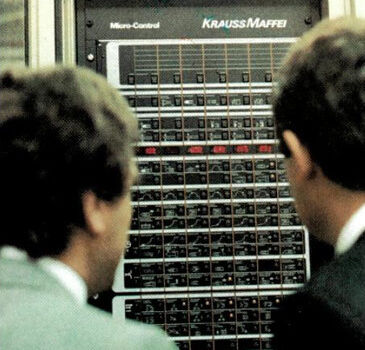
Inspirations
Composites: Complete solutions with an array of applications
| KraussMaffei
Interview with the lightweight construction experts Philipp Zimmermann and Dr. Mesut Cetin
Lightweight engineering methods traditionally have an important role to play wherever cutting weight is an objective. But they have far more to offer besides this. We asked two experts to tell us more about the many advantages of lightweight engineering.

Philipp Zimmermann
is Head of Sales and Projects Reaction Process Machinery at KraussMaffei.
ahead
In 2015, the BMW 7 Series was the first car in its class to incorporate carbon-fiber-reinforced polymer (CFRP) components in a mass-produced vehicle. 2017 saw the launch of the A8, with a CFRP ultra-torsion-resistant rear panel in the passenger compartment. Ferrari is currently being hailed for creating the new Portofino, weighing in at 80 kilos less than its predecessor. The knee airbag from ZF receives an award for its lightweight housing, which saves 30 percent in weight. Doesn’t all this make the automotive industry a key driver in the field of lightweight engineering?
Philipp Zimmermann
There’s certainly no doubt that lightweight engineering has played an important role in the automotive industry for years. Weight reduction was previously one of the foremost factors in reducing aspects such as fuel consumption. But electric vehicles are changing this. Put simply, the equation is now as follows: increased performance plus potential cost reduction divided by functionalization and amalgamation of individual components.
ahead
And where is KraussMaffei in this equation?
Zimmermann
Right at the heart of it. For example, we and our partners have developed and built a suspension spring for our customer Hengrui, for use in a car. This spring can be up to 60 percent lighter than the steel springs previously used, and is primarily made from fiberglass and epoxy resin. We can tweak the design to increase strength at exactly the points where it is needed. And, of course, this material never corrodes.

Dr. Mesut Cetin
is Group Leader Product Management Automation in the Thermoplastic Components division.
ahead
So lightweight engineering really lives up to its name?
Dr. Mesut Cetin
The door module carriers we produce for a major automotive manufacturer are molded from 0.6mm organic sheet and back-injected. They save six kilos in weight compared to the same part in steel. Even their injection-molded predecessor was 1.5 kilos heavier. Thanks to our advanced automation system and smart heating technology, we can make one of these door carriers in a cycle time of less than 60 seconds. For example, the step of applying the preheated organic sheet to the mold takes no more than two seconds. So we certainly can be fast. But this door carrier also has quite different advantages to offer.
ahead
… What are they?
Dr. Cetin
As Philipp has already mentioned, integration and functionalization are the key concepts. The door module carrier serves as a frame on which a whole host of other components are mounted – inner and outer shells, speakers, locking module, crash sensor, motors for raising and lowering the windows, and so on – plus the window regulator rails, which used to be fitted in a separate work step. Now the rails are injection-molded straight onto the molded organic sheet. The module also opens up new options for acoustic design, and the load-path-optimized fiber reinforcement offers up to 400 percent greater energy absorption than the previous carrier design.
ahead
Why haven’t all-composite cars long become standard?
Zimmermann
The automotive industry is based on metal and sheet metal working. Production lines all over the world are optimized for these metal working processes. A widespread move to fiber-reinforced polymer would involve enormous efforts and costs.
Dr. Cetin
In any case, a complete shift would not be practical in many respects. Take Class A surface quality; here, metal is still far ahead. Component design using composite materials is also a complex process because of their anisotropic properties – in other words, the materials show different properties in different directions.

A complete shift of the automotive industry
to Composites would not be practical, sys Dr. Cetin
ahead
Skilled metal workers know exactly how thick the metal sheets need to be so that they have the desired properties once they are moulded. Doesn’t this work for composites?
Dr. Cetin
The design process for organic sheets, say, is extremely complex; the finished product needs to deliver the desired properties after the organic sheet has been coated with matrix material and molded. This is a far more advanced process than the simulations that are available for standard injection-molded components. Of course the topic is being addressed by specialists, who are usually the manufacturers of the materials.
Zimmermann
Not forgetting the various different production processes that are in use for composite polymers, which offer different advantages depending on the component involved. The spring we mentioned, for example, is produced using high-pressure resin transfer molding (HP-RTM). So first you need molded semi-finished products into which you then inject the matrix material, then you have to use pressing force to hold the mold in position until the reaction is complete. Other methods, each of which requires different specialist expertise, are pultrusion and the organic sheet/injection molding combination that we mentioned before. Composite technology is enormously complex, but delivers extremely interesting results – not only for the automotive industry.
ahead
What about industries where weight is also a key issue, like shipbuilding, aviation, and aerospace?
Zimmermann
If you think of the hull in relation to shipbuilding, that’s actually outside our area; the numbers of units produced are too small. Our strength lies in large-volume manufacturing. But aviation is actually an extremely promising line of business.

"Our strength lies in large-volume manufacturing",
says Philipp Zimmermann.
ahead
So are Airbus, Boeing and the rest concerned about more than just weight?
Zimmermann
The aviation industry is seeking ways of streamlining its processes to increase its unit numbers. This is where our experience from the automotive industry is extremely valuable; for example, we completed a development project for Airbus involving a door side frame. Using conventional production methods, several hours per frame had been scheduled for the door frame. We managed to reduce that time to less than an hour, saving significant amounts of time per component.
Dr. Cetin
When it comes to the use of thermoplastic components in this market, one obstacle is the temperature resistance of common polymers as matrix materials. Materials manufacturers are now using polyetheretherketone, or PEEK, as matrix material for organic sheets. PEEK has a melting point of over 300 degrees and is thus far more heat-resistant than the other common plastics such as polypropylene or polyamide. This may boost the use of organic sheets in this market.
ahead
Do you have new lines of business in view?
Dr. Cetin
We have already produced thermoplastic parts for ski bindings, and the aerospace industry is bound to take on greater importance in the coming years. But automotive will continue to be a major field for us. It’s essential to understand that when we use organic sheets, our primary aim is not to replace metal components. Our main objective is to optimize and functionalize injection molding applications. This is a relatively small step for our customers, whereas replacing metal parts with composite would be a whole different ball game.

Thermoplastic parts for ski bindings
KraussMaffei produced with the FiberForm technology
Zimmermann
Pultrusion is currently in the spotlight in the field of thermosets. This is an area where initial investment is relatively low, so that products can be created that we would normally not even associate with fiber composite technology – like window profiles. The construction industry uses vast amounts of reinforcement material in reinforced concrete; but why should this be the conventional choice of metal if the same strength can be achieved using different types of reinforced beams or whole rebars? In this context, the huge advantage of fiber composite technology is its corrosion resistance. And pultrusion is an extremely efficient method for producing pretty much any object that needs to combine length and strength. There’s a whole host of potential applications.

The construction industry
will increasingly demand lightweight components in the future.
ahead
Where do you think the lightweight engineering sector will be in five years’ time?
Zimmermann
Automotive will continue to be a focus for us, while aviation will increase in significance. It’s also clear that in the coming years, our technology will enable us to introduce lightweight engineering in completely new sectors such as infrastructure and construction. Interesting material properties, short cycle times and lower production costs are the main aspects here.
ahead
And what about expanding your areas of expertise?
Dr. Cetin
We operate in mechanical engineering first and foremost, and we ensure that our customers can use our systems to manufacture their products in reproducible quality that complies with requirements and specifications. That means that today the entire engineering process – the planning and development of a component from start to finish – is undertaken by partner companies, as is the manufacture of the initial material and the tools. Over recent years we have built up a solid network of companies with which we work well and reliably, involving our customers in the process. This provides clear-cut added value for our customers.















